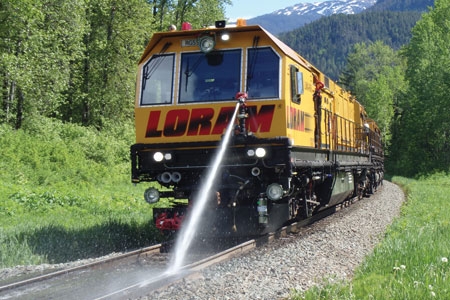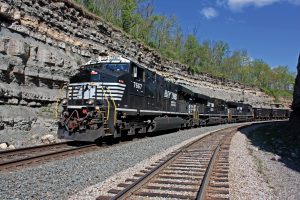Refining profile and saving face
Written by Mischa Wanek-Libman, editor
Success in battling defects and extending the life of a rail can be met with a well-planned grinding or milling program.
{besps}April16_Grinding{/besps} {besps_c}0|1grinding.jpg| A graph showing an example of Harsco’s Dynamic Pattern Generation.{/besps_c} {besps_c}0|2grinding.jpg| Simulation of Harsco technology being used to develop an ideal rail template.{/besps_c} {besps_c}0|3grinding.jpg| oram’s RGS specialty grinder operating in Penny, B.C., Canada.{/besps_c}
Success in battling defects and extending the life of a rail can be met with a well-planned grinding or milling program.
Traffic density is putting pressure on grinding and milling suppliers to provide service in a speedy yet efficient manner. Railroads and transit agencies need machines that are quiet in urban areas, reduce or eliminate dust production, can operate in restrictive environments and perform the job safely. Suppliers of these maintenance services provide a variety of equipment aimed at refining a rail’s profile by the most effective means possible.
New technology, collaborations
Harsco Rail has recently introduced Dynamic Pattern Generation as part of its grinder technology. Harsco explains that this enhancement provides the grinder with a mechanism to orient grinding motors based on measured rail profile, desired rail shape (template) and resulting metal removal effort.
“In the past, grinders used ‘canned’ patterns with predefined motor orientation and contact pressure,” said Joe Palese, Harsco Rail’s senior director – engineering and technology. “The primary variable that was available to the operator was the speed of grinder travel. With this enhancement, grinding motor orientation and contact pressure can be changed (along with grinder travel speed) for a specific grinding segment using sophisticated simulation technology to achieve the desired depth of metal removal at the proper location. This simulation is performed iteratively to define the number of passes the grinder must take in each direction and the motor orientation at each pass. This becomes particularly effective for smaller grinders that do not have enough grinding motors to achieve full rail head coverage in one grinder pass.”
He explained that in order to grind to a desired shape, templates must be defined to control the wheel/rail interface. Additional technology has been developed, which simulates the contact stress associated with the wheel/rail interface and this is used to define templates. Palese says that by collecting rail and wheel profile data and applying this simulation technology, Harsco Rail is able to provide customers with desired grinding templates specific to their conditions and operation.
“Railways worldwide have increased requirements for grinding to predefined metrics, while achieving increased efficiency,” said Palese. “Specifically, railways want to ensure that the proper rail profile is left behind and corrugation (or other rail surface anomalies/defects) are removed, while achieving the maximum grinding speed and optimal metal removal. Harsco Rail provides this by monitoring the rail profile condition using a grinding quality index (a measure of profile/template conformance) and measuring and monitoring rail corrugation. In this manner, the grinding operation can be monitored as to its effectiveness and rail condition can be accurately measured and easily visualized during grinding.”
Harsco Rail and RailWorks Maintenance of Way, Inc., have partnered to provide grinding services to Class 1 customers. The services are led by RailWorks operating personnel who utilize technical support from Harsco as needed.
“Inquiries from Class 1 customers prompted us to begin a search of manufacturers that supply on-track switch and crossing grinding equipment,” said R.T. Swindall, vice president of RailWorks Maintenance of Way. “We were looking for a partner with expertise and industry leadership in heavy on-track equipment. Our search didn’t take long as Harsco was immediately identified as the world leader for this type of equipment.”
Swindall explains that RailWorks’ goal with the service is to provide an additional rail grinding solution that is service oriented and customizable.
“Over the past year, we’ve had great success partnering with Harsco to provide a higher standard of service. We have a strong, value-driven offering that combines Harsco’s manufacturing expertise with RailWorks’ proven field knowledge for managing and executing on-track heavy equipment services,” said Swindall. “In March, we just began operation of a new switch and crossing grinder for a Class 1 railroad that will work in the New England and Chicago areas. Our plan is to stay close to our customers and expand grinding and other services to meet their demands.”
Product diversity
Loram Maintenance of Way, Inc., offers a diverse grinding product line that includes the RG 400 Series – Heavy Haul, C44 Series – International, RGI – International, RGS – Specialty and the L Series – Mobile/Specialty/Transit.
The company says one of its most successful products has been the 400 Series Grinder, which has experienced strong demand on many heavy-haul railways in North and South America and Australia. Loram says the RGS Series allows customers to optimize productivity, reduce cost and increase asset life of switches and crossing rail. Loram’s RGI Series and C44 Series are designed with the latest technology to help meet grinding needs in restrictive areas and the company says the L – Series Grinder is the most productive “truckable” option on the market.
Loram says it refines the accuracy of its grinding process by continuing to study the deterioration of rail and causes for variation, incorporating those findings into the decision-making process. The company collects data from every North American Class 1 at various test sites.
“Refinements in the grind plan development process continue to improve the ability to achieve the profiling and metal removal objectives at the maximum efficiency,” said Loram.
For Loram, efficiency of its grinding process is critical as traffic density continues to increase.
“We foresee continued movement toward precision in achieving the desired profile and removing the fatigued metal, all while removing as little metal as is required at the fastest speeds possible. Less metal removed artificially through grinding leaves more of the rail head and extends the life of the rail, provided adequate metal is removed to accomplish the objective. Precision is required to ensure this is the case. Less metal removal required allows even faster speeds, fewer passes, less time spent in a block and a lower cost per track mile. Speeds will continue to be limited by the need to provide precise profiling of the rail, as well as line of sight requirements for machine operation,” said Loram.
Multi-faceted machine
Orgo-Thermit, Inc., operates a VM8000, 12-stone grinding vehicle that is equipped with four-wheel steering. The company says the machine is capable of road driving, which allows for quick on- and off-track movements, as well as the ability to drive to the grinding site without occupying track time.
Another feature Orgo-Thermit points out is the grinding ability to skew its wheels to “slide” out of the way of an oncoming train and return to its original position. The company said it upgraded the unit’s dust collection system, which means there is minimal dust in open track and almost non-existent dust in embedded track, an accomplishment that has won Orgo-Thermit praise, especially for work in crowded areas.
“We are working with customers to implement profiles to allow the conicity of wheel treads to help steer the train. This helps to not use the track to steer and keeps the high rail in curves from wearing,” said Pete Capiak, rail grinding supervisor. “Our quality of the finished product is second to none. We can easily grind directly through crossings and switches. With Orgo-Thermit’s experienced team, the mounting time is kept to within 25 seconds. This allows the stoppage of traffic, pedestrians and trainsto be kept to a minimum.”
He also says noise is always a major issue for transits in residential areas and notes the VM8000 is very quiet, noting that a normal conversation can be held while standing 10 feet from the machine.
Capiak says the finish goes hand-in-hand with keeping operations quiet and can be a delicate balance especially when it comes to not sacrificing power.
“Orgo-Thermit has done much research to get an even finer finish. The VM8000 leaves behind very tight facets (with no ridges) and a scratch mark of three to six micron. Orgo-Thermit has developed specialized grinding stones for different situations. Mill scale removal has always been the hardest to complete and keep passes to a minimum. With this new stone, the passes have been cut in half for mill scale removal. This helps to keep up with transit’s needs for increased production on shorter track times. Orgo-Thermit has also developed a Fine Finish stone. This stone leaves behind an immaculate finish, creating an absolute silent environment, when a train passes. There is no longer the need to wait one or two weeks for the train to wear in,” said Capiak.
Mobile milling
Vossloh Rail Services is focused on finalizing an advanced concept for mobile rail milling, which is expected to be available by the end of 2016.
“Rail replacement is a major expenditure for any railroad or transit – milling makes it possible to fully refurbish and recover the rail, thereby extending the life of the rail. As milling is a cutting process (and not a grinding process), it is used for high rates of metal removal and where conventional grinding practices are not effective or can’t be used. Vossloh mobile rail milling is a corrective machining technology developed for full rail refurbishment, meaning removal of all defects and restoration of cross profile, in one pass, depending on the amount of metal removal required. Another major advantage of this technology is the elimination of fire hazards. Milling does not produce sparks and dust like grinding does. Milling can be used in dry areas, bridges and tunnels and in environments where rail grinding cannot be used,” said Ron Martin, general manager and vice president of Vossloh in North America. “The perceived drawback of milling is the limited working speeds, but with its high metal removal rate, corrective milling is faster than grinding when full rail recovery is considered. Vossloh’s mobile rail milling service has been successful in numerous countries around the world and we see a great opportunity for North American railroads to supplement their present grinding strategies with milling, especially in areas where grinding cannot recover excessively damaged rail, or in areas where grinding is too hazardous or not able to be used at all.”





